| Title | Tail Concerto |
| Released | April 16, 1998 (JP) November 3, 1999 (NA) |
| Developer(s): | CyberConnect2 |
| Publisher(s): | Bandai Co., Ltd. Atlus U.S.A., Inc. |
| Platform(s): | |
| Genre | Action-Adventure, Platformer |
| Rating | E |
Completed on PlayStation on Normal
HowLongToBeat Time: 5 Hours | My Clear Time: 3 Hours 38 mins
Background
Released on April 16, 1998, for the PlayStation, Tail Concerto was developed by CyberConnect (now CyberConnect2) as their first project and published by Bandai in Japan and Atlus in North America. This was before Atlus became widely known in the West for the Shin Megami Tensei and Persona series, making Tail Concerto one of their earlier localization efforts. The game serves as the first entry in what would later become the Little Tail Bronx series, which includes Solatorobo: Red the Hunter and Fuga: Melodies of Steel.
Tail Concerto introduced players to a whimsical, steampunk-inspired world, populated by anthropomorphic characters. Below is the opening cutscene, which sets the stage for the charming and adventurous atmosphere the game is known for.
Originally envisioned as a sandbox-style open-world game inspired by Super Mario 64, Tail Concerto underwent significant changes during development. The early prototype featured vast environments with little density, leading to a lack of engaging gameplay.
To fix this, the team shifted to a more structured, visually rich world with floating cities that better supported its narrative-driven action-platforming. The game’s first major stage, Resarca, went through four complete revisions and took over six months to finalize, as the developers meticulously balanced level design, camera angles, and environmental detail to ensure a cinematic feel. This extensive iteration process meant that the rest of the game had to be completed in just eight months.
With a small development team, many members took on multiple roles. Niiza, one of the key planners, not only worked on level design but also handled storyboarding, gameplay mechanics, and pixel work for character face graphics.
The game’s striking steampunk-inspired world, populated by anthropomorphic characters, was shaped by concept artist WAKA, whose early illustrations of floating cities and forests guided the game’s aesthetic direction.
In an interview with Inside Games, CyberConnect2 president Hiroshi Matsuyama described the development as challenging, with frequent revisions to balance visuals, gameplay, and world-building.
“It took more than six months to make the first stage. The remaining time was crazy.” – Hiroshi Matsuyama
Inside Games
Although Tail Concerto was not a major commercial success, it gained a cult following due to its charming art style, engaging world, and unique blend of action and adventure. Its legacy lives on through its sequels and CyberConnect2’s continued dedication to the Little Tail Bronx universe.
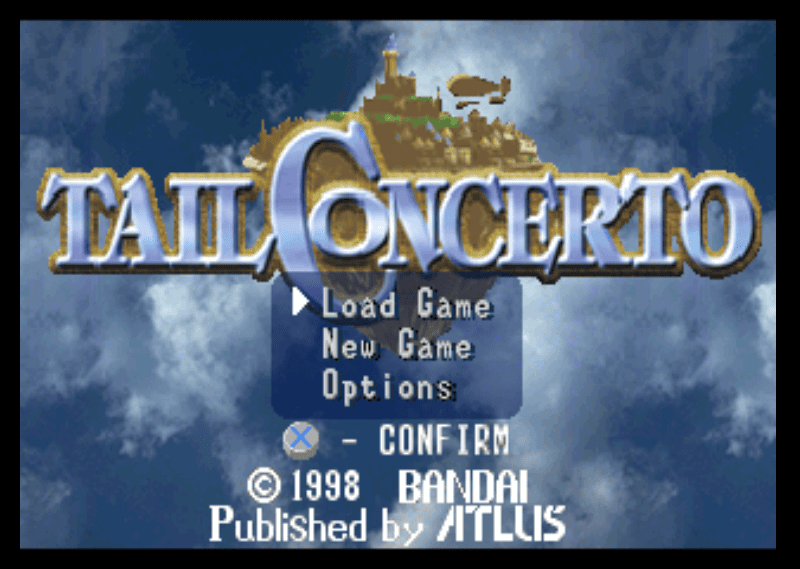
The main menu sets a cheerful tone with floating clouds and classic PS1 charm.
The development team for Tail Concerto includes:
- Hiroto Niizato (Writer)
- Known for Tail Concerto, .hack//Infection, .Hack//G.U, Fuga Melodies of Steel 1-2
- Hiroshi Ishiodori (Director)
- Known for Tail Concerto, The Rumble Fish, AquaPazza: AquaPlus Dream Match
- Nobuteru Y?ki (Character Illustrations)
- Known for Record of Lodoss War, Chrono Cross, Solatorobo: Red The Hunter
- Chikayo Fukuda, Seizo Nakata (Composers)
- Chikayo known for .hack//Infection, .hack//G.U., Asura’s Wrath, Fuga Melodies of Steel 1-2
- Seizo known for .hack//Infection, .hack//G.U., Asura’s Wrath, Fuga Melodies of Steel 1-2
- Tetsuhisa Yamada (Producer)
- Known for Tail Concerto, Langrisser I & II, Detective Conan
Experience
As someone who appreciates action-adventure games from the PlayStation era, Tail Concerto immediately caught my attention. Its colorful, whimsical world stood out against the grittier, more realistic aesthetics of the late ‘90s. Having experienced CyberConnect2’s later works, such as Asura’s Wrath and JoJo’s Bizarre Adventure: All Star Battle, I was curious to explore the studio’s roots with their first project in the Little Tail Bronx series.
Tail Concerto gave me a unique insight into how CyberConnect2 began crafting its character-driven narratives and emotional storytelling. The emphasis on quirky, heartfelt characters is something that became a signature of their later games. Revisiting this early title, I was able to see the foundations of the studio’s evolution, from the more straightforward gameplay of Tail Concerto to the dramatic, cinematic storytelling of Asura’s Wrath.
As someone who’s also interested in the Fuga: Melodies of Steel games, playing Tail Concerto felt like a natural starting point. It deepened my appreciation for how far CyberConnect2 has come and helped me better understand the origins of the Little Tail Bronx series.
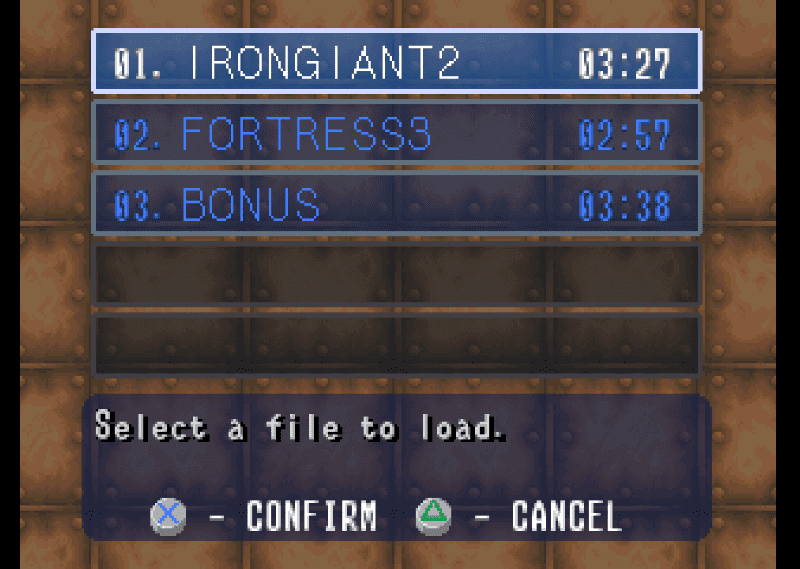
Hovering over the clear save with 3 hours 27 minutes played.
Impressions
Introduction
At its core, Tail Concerto is a lighthearted, story-driven action-adventure game that leans heavily on its worldbuilding. Set in the floating island nation of Prairie, the game features a vibrant world inhabited by anthropomorphic dogs and cats. The narrative follows Waffle Ryebread, a canine police officer, as he unravels a conspiracy involving ancient artifacts, a rebellious feline faction, and strained childhood friendships.
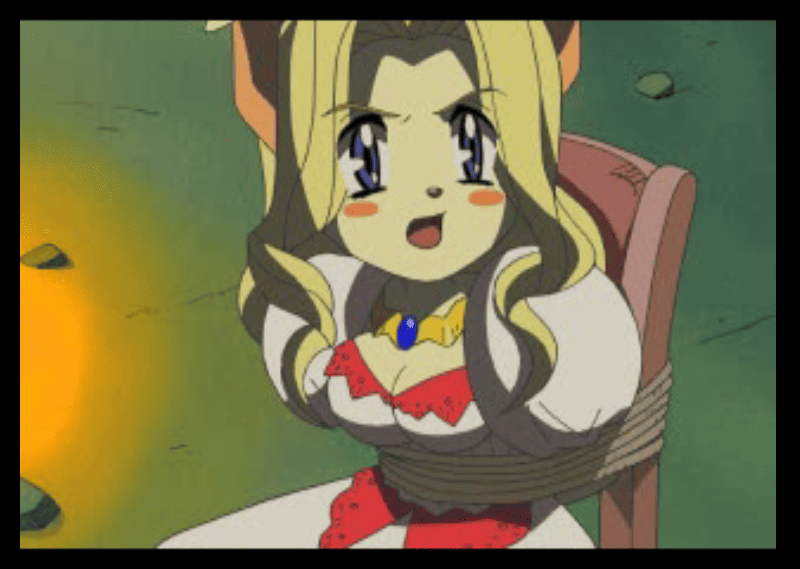
Princess Terria sits tied up, clearly annoyed.
Visually, the game channels a charm reminiscent of the .hack//sign anime, blending whimsical character designs with a detailed, immersive world. This style would go on to influence CyberConnect2’s future works, helping establish the studio’s distinct visual identity.
Gameplay and Mechanics
One of Tail Concerto’s greatest strengths is its simplicity and accessibility. The game allows for non-linear exploration, meaning you can travel to different locations in any order. If you ever find yourself stuck, simply returning to the central hub, Porto, and speaking with NPCs can provide hints or unlock new travel destinations on the world map. This flexibility makes the game feel inviting and allows players to progress at their own pace.
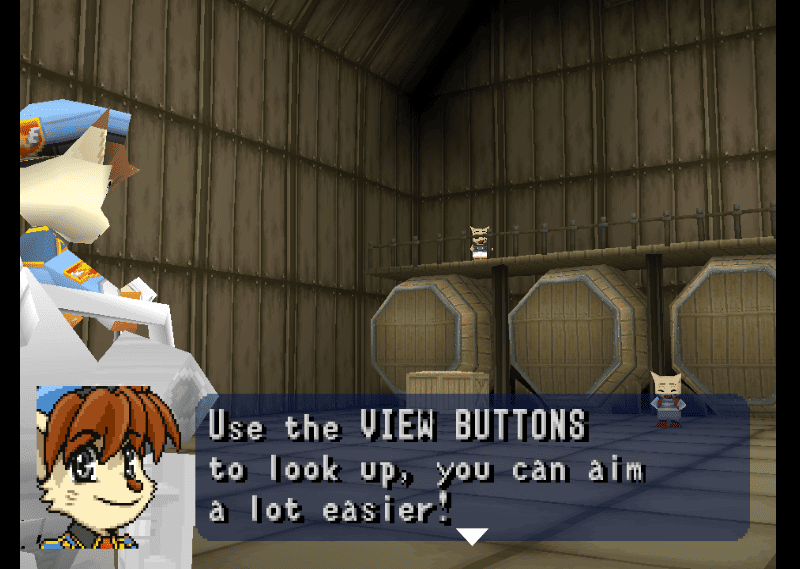
Using view buttons to adjust your aim inside Waffle’s mech.
Platforming and Navigation
The platforming in Tail Concerto is straightforward but can sometimes be tricky, especially when dealing with climbing and jumping. There’s a noticeable emphasis on verticality, with many sections requiring you to leap between platforms or cling to pipes. Fortunately, the game uses color-coded visuals to make these platforming spots clearer, indicating whether you’re parallel with a grabbable surface or not. This system helps reduce some of the frustration that comes with platforming sections, making the gameplay feel more intuitive.
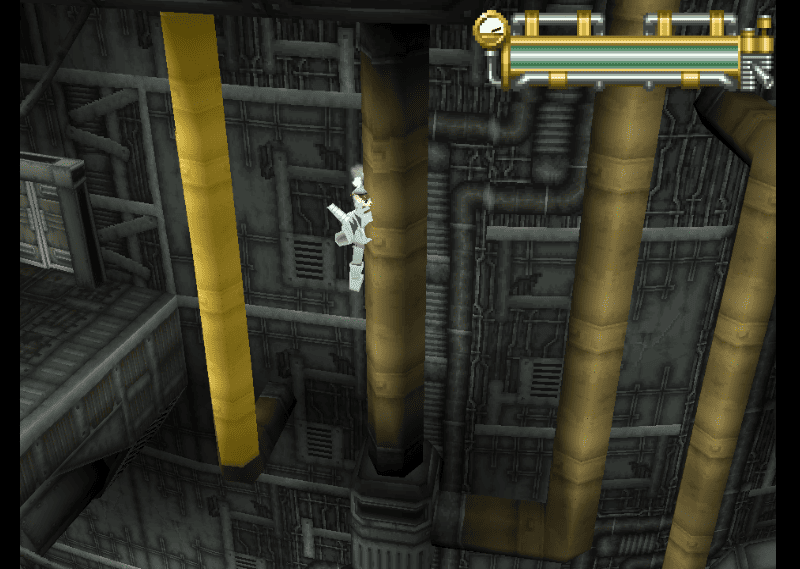
Waffle lines up a precise jump between pipes.
However, despite these helpful cues, the camera remains one of the biggest obstacles in Tail Concerto. Much like players of Core Software’s Tomb Raider series might attest, the camera in Tail Concerto can feel unpredictable, especially during platforming segments. In some cases, it’s not always easy to gauge your surroundings, which can lead to unfortunate deaths due to missteps.
The most egregious example of this occurs in the final area of the game, where the physics feel reminiscent of the Moon Physics modifier in Tony Hawk’s Pro Skater—jumps are exaggerated, platforms are harder to land on, and the floaty feeling of the jumps makes precision difficult.
Overall Design & Bosses
The game’s design feels relatively forgiving compared to other action-platformers, with the camera issues being more of a growing pain than a consistent hindrance. As you progress through Waffle’s adventure, the more you learn to work around the camera’s quirks, turning it into a minor challenge rather than something that detracts from the overall experience.
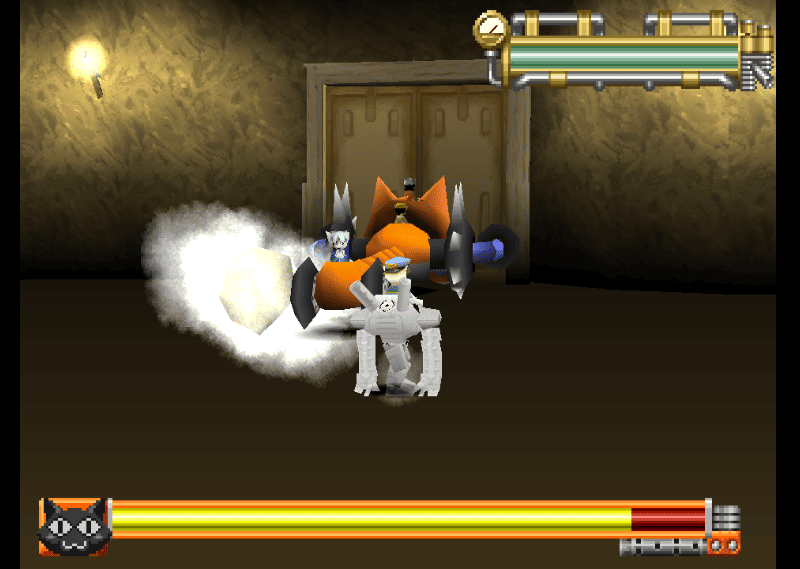
The boss gets stuck, giving you an opening.
The bosses in Tail Concerto are another highlight, with each one providing a unique challenge. From giant mechanical foes to more intricate combat scenarios, they offer a fun mix of action and strategy, contributing to the game’s lighthearted, yet engaging, feel.
Art & Audio
Tail Concerto’s cel-shaded art style gives the game a storybook-like charm, with each area offering a fresh visual experience. From the floating city of Resaca to lush forests, wintery snowscapes, and rugged mountainous terrain, the diverse environments keep exploration exciting and help reduce monotony. Nobuteru Y?ki’s character designs shine, each one bursting with personality—whether it’s Waffle’s approachable energy or the mischievous Black Cat Gang. The exaggerated features give the characters a whimsical, approachable feel, perfectly complementing the game’s lighthearted tone.
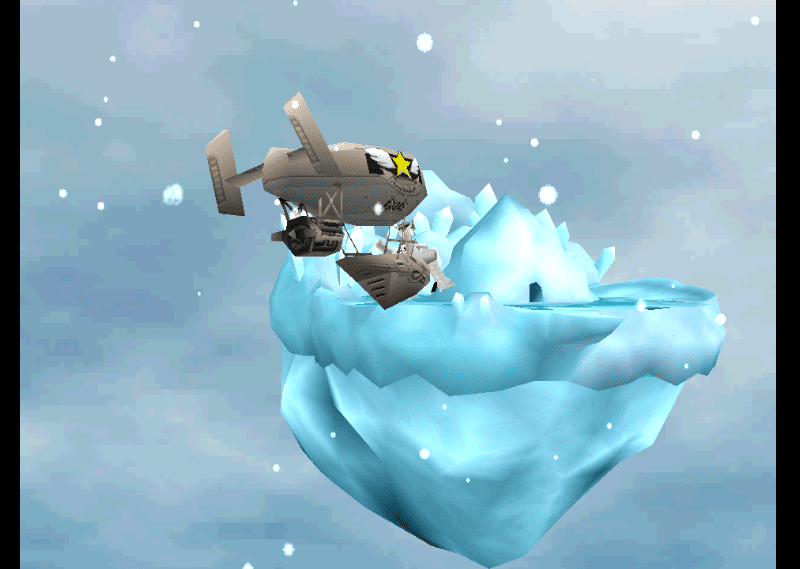
Waffle soars into the icy expanse.
The overall art direction evokes Studio Ghibli charm, making the world feel effortlessly lively and playful. It brings to mind the warm, adventurous spirit of Porco Rosso, where even the smallest details—like the mechanical designs and anthropomorphic characters—are treated with the same love and care that Ghibli films are known for.
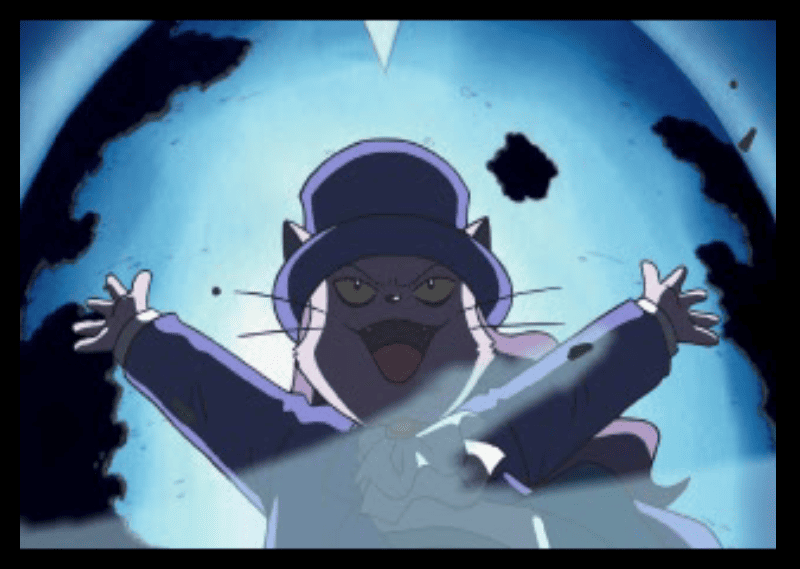
Fool revels in his mischievous triumph.
The cutscenes, in particular, feature a hack//sign-like aesthetic, with soft pastel colors and fluid character animation that give them an anime-inspired, cinematic quality. This enhances the game’s immersive world.
Chikayo Fukuda’s whimsical soundtrack fits the game’s tone perfectly, with standout tracks like the lively Resaca theme and others that shift between playful and mysterious, mirroring the story’s emotional moments. The music strengthens world-building, with diverse styles reflecting the different regions. The upbeat tracks energize players during action sequences, while the more atmospheric pieces in quieter sections help ground the story’s more reflective moments.
Story & Writing
The story in Tail Concerto is straightforward but full of heart, with its simplicity lending itself to a charming, lighthearted adventure. The relationships between characters, particularly between Waffle and Alicia, are developed just enough to be engaging, giving depth to their interactions. The themes of friendship, duty, and understanding different perspectives elevate the narrative beyond its initial surface-level adventure, infusing it with emotional weight.
At the core of the conflict lies a fundamental misunderstanding—the antagonists’ belief that the dog people despise the cat people. This misconception drives much of the tension and provides an emotional undercurrent to the plot. While the story may seem light on the surface, it cleverly weaves in these deeper themes of communication, empathy, and the consequences of misguided assumptions.
Unique Features & Mechanics
Tail Concerto stands out for its innovative use of fully 3D environments, which was ahead of its time for a PlayStation title. Though not as expansive as later open-world games, the game’s floating islands and airship travel offer a surprising sense of freedom, setting it apart from typical platformers of the era. This openness not only encourages exploration but also complements the game’s whimsical tone.
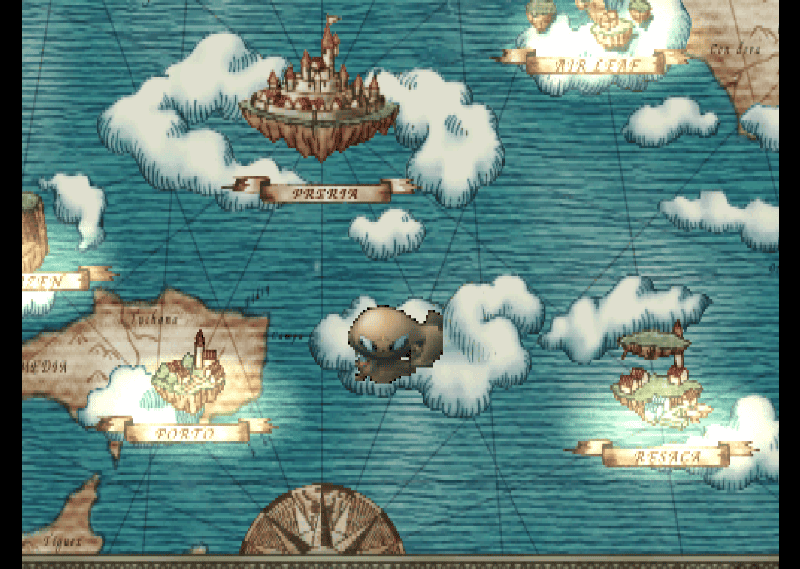
The airship map lays out your next destinations.
Another unique feature is the game’s focus on capturing enemies rather than defeating them. This mechanic gives Tail Concerto a distinct identity compared to other action-adventure games of the time, prioritizing strategy and puzzle–solving over traditional combat. The emphasis on non-lethal capture creates a gameplay experience that’s both engaging and approachable.
Voice Performances
One standout feature of Tail Concerto is its fully voiced dialogue, which was impressive for a PlayStation game of its time. The inclusion of voice acting, particularly in an era when many titles still relied on text boxes, adds an extra layer of charm and personality to the cast. Though limited by the hardware and the era’s audio technology, the performances manage to bring the characters to life, with a surprising amount of warmth and emotion.
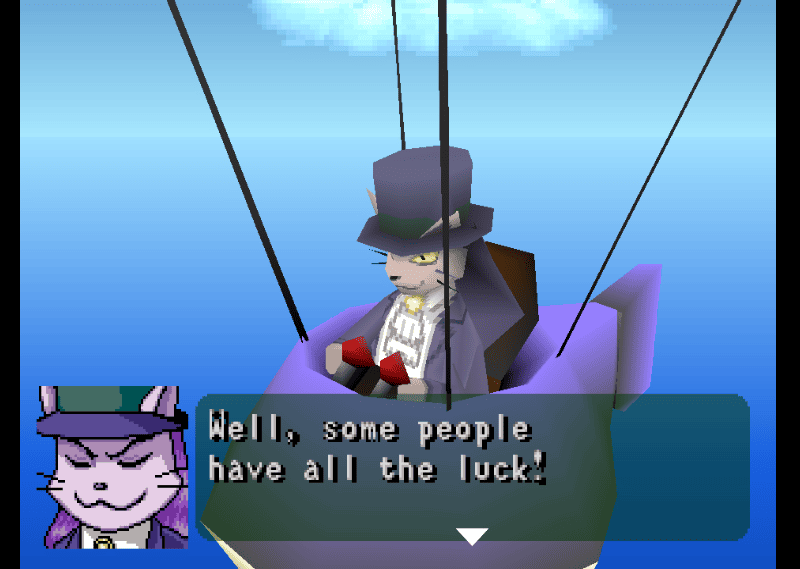
Fool’s frustration is clear aboard his blimp.
In particular, the English dub is competent for its time, with voice actors capturing the playful and adventurous spirit of the characters. While some performances might feel a bit stiff by today’s standards, they still serve the game’s whimsical tone well, enhancing both the humor and emotional moments throughout the story.
- Lani Minella
- Known for Rouge The Bat from Sonic Adventure 2, Isabella Valentine from SoulCalibur, Maya Amano / Lisa Silverman from Persona 2: Eternal Punishement
- Amanda Winn Lee
- Known forYukiko Amagi from Persona 4, Rei Ayanami from Neon Genesis Evangelion, Argilla from Shin Megami Tensei: Digital Devil Saga
- Carrie Gordon-Lowrey
- Known for Hotaru from .hack//Legend of the Twilight, Palma from Thousand Arms, Jaina Proudmoore from Warcraft III: Reign of Chaos
- Ari Ross
- Known for Tommy Parsy from Snowboard Kids 2, Bolt from Thousand Arms, Fafnir from SMITE
Verdict
Tail Concerto is a charming and whimsical action-adventure that captures the spirit of the PS1 era with its colorful world, lovable characters, and engaging music. While its gameplay offers a simple yet enjoyable experience, it does suffer from camera issues that can lead to frustration, particularly during platforming sections.
The mechanics don’t evolve much over time, which can feel repetitive in extended sessions. However, the game’s world-building, emotional story, and unique capture-based combat more than make up for its shortcomings. For those who appreciate hidden gems from the PS1 era, Tail Concerto offers an adventure worth experiencing—though the camera frustration is something to be mindful of.
TLDR
Tail Concerto (PS1)
7
Good
Summary: Tail Concerto is a charming and unique adventure that combines colorful, storybook-like visuals with fresh gameplay mechanics. While its basic gameplay and occasional camera issues may cause frustration, the game’s whimsical soundtrack, heartfelt story, and distinctive art style make it a hidden gem from the PS1 era.
Its memorable characters and exploration-focused design offer a delightful experience for fans of lighthearted platformers, though its lack of combat depth may limit long-term enjoyment.
References
- Opening – Tail Concerto
- Gamachi, G. (2015, March 3). Interview to celebrate the release of the “Tail Concerto” setting materials collection! The three crosses are now revealed, and Hiroshi Matsuyama’s true feelings. Inside-Games.
- Resaca – Tail Concerto OST
- Iron Giant’s Revival – Tail Concerto



Leave a Reply